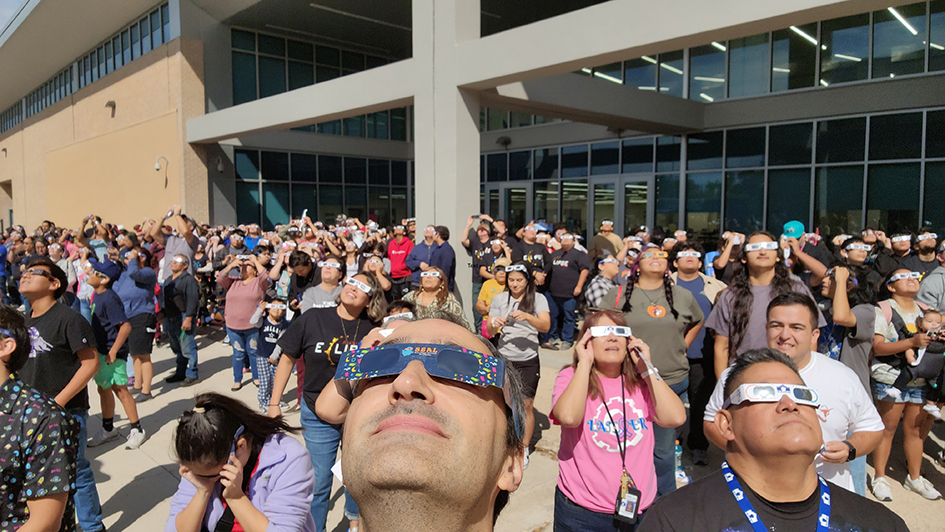Background
San Antonio is at the intersection of the annular solar eclipse on October 14th, 2023 and the total solar eclipse on April 8, 2024, providing an exceedingly unique opportunity to directly connect these celestial events with STEM (science, technology, engineering, and mathematics) careers and education.
The back-to-back solar eclipses will undoubtedly inspire a curiosity and fascination with the cosmos and STEM in general among those who witness them. This PDIR contains elements of all four areas that constitute independent research and development through (1) increasing public knowledge in science by stimulating interest and curiosity in scientific phenomena as an introduction to basic research; (2) providing the public with the underlying science and mathematics needed to understand how eclipses occur and what we can learn from observing them and other astronomical objects and events; (3) including elements of engineering intended to exploit the potential for observing solar eclipses using telescopes and optical devices with the appropriate solar filters that support the potential scientific discoveries that may arise through dedicated studies of the Sun, its corona, the solar wind, and the solar wind’s interaction with the Earth’s magnetic field; and (4) allowing SwRI and the public to evaluate scientific instruments and equipment and learn how to use them the advance scientific knowledge, educating future scientists and engineers on the systematic application of scientific knowledge and engineering design.
Through established and new partnerships within the greater San Antonio community, as well as leveraging existing SwRI-led eclipse outreach efforts funded by NASA and the NSF, this program supports the purchase of materials needed for the public to safely experience the solar eclipses and the time and expertise needed to develop new materials in order to work directly with teachers, schools, and the public in the San Antonio community.
Approach
To achieve the goals of this program, we capitalize on the expertise of the scientists and engineers who work at the institute. This includes using their knowledge for the development of materials such as short videos that provide the scientific and mathematical background needed to explain the eclipses, the development of a website with reference and safety information about the eclipses, and the development of presentation materials for SwRI STEM experts to go into the public and into schools to promote awareness about these celestial events and provide the necessary science context for the eclipses, solar system dynamics in general, and information about being a professional in a STEM field.
The program also leverages materials and outreach efforts that have been funded by NASA through the PUNCH mission and the citizen science program CATE 2024 funded by NASA National Science Foundation.
Through a strong partnership with the San Antonio Independent School District (SAISD), we are working with administrators and teachers to extend the reach of knowledge and inspiration for basic research into the classrooms over the course of the school year. By partnering with Workforce Solutions Alamo, which is invested in developing technical skills for students across 13 counties in the San Antonio area, these same efforts are extended into more rural communities. Additional partnerships with local museums, colleges, and the San Antonio Library System provide various additional events and venues for which subject matter experts (SME’s) from SwRI can achieve the goals of the PDIR.
Accomplishments
Leading up to the Annular Eclipse on October 14th, 2023, the PDIR successfully supported a series of events and material development to achieve the goals of the program.
Three “Quick Take” ~2-minute videos have been filmed explaining the science, math, and engineering behind solar eclipses and the exploration of our Solar System. One finished film has been shared with SAISD, which was distributed to all 45,000 students across their 99 schools. These videos are filmed by a former SwRI intern who is now a communications student at the University of Texas San Antonio.
The keynote presentation at the SAISD Teachers’ Professional Development Day highlighted the ways the eclipse could be brought into all classrooms, including into history, culture, arts, and language courses. Additional presentations and hands-on activities were conducted by staff from SwRI with the teachers in smaller groups. We also supported an additional event at the DoSEUM that provided resources and activities related to the solar eclipse for 250+ teachers in the San Antonio area.
STEM experts from SwRI gave multiple presentations at libraries and school events centered around the eclipses. One such event included a meeting of the Low Vision Club, where unique resources to experience and understand the eclipse were provided to those who are visually impaired.
On October 14th 2023, SwRI staff supported at least ten Annular Eclipse and STEM activity days organized at SAISD schools; each event hosted between 80 – 300 students and their families. UTSA-SwRI graduate students supported an event in Uvalde hosted by the grief center, as well as events at the San Antonio missions. SwRI staff also supported large events hosted by the San Antonio Museum of Science and Technology at the Boeing Center at Tech Port and at the San Antonio College’s Scobee Education Center, which reached thousands of members of the public. We estimate the direct impact of events that SwRI has led and supported so far exceeds 4,000 people; however, the approach of focusing on providing resources to teachers means the knowledge and inspiration for basic research will continue to propagate into the classrooms for years to come.

Figure 1: Retired SwRI engineer Scott Pearson and Group Leader Tracy Becker sharing eclipse materials, including pinhole projectors for the SwRI-led PUNCH mission, with nearly 3,000 people who attended the La Fiesta Del Sol event hosted at the San Antonio College’s Scobee Education Center.

Figure 2: Lead Scientist Cesare Grava viewing the annular eclipse with Lanier High School students and their families, where he served as an eclipse subject matter expert during one of dozens of events hosted at schools across the San Antonio Independent School District.
